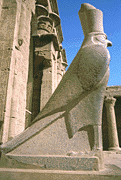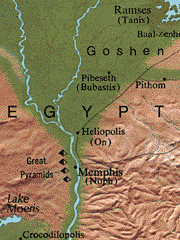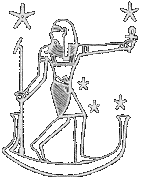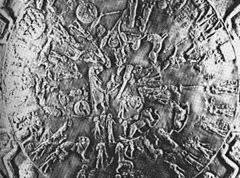

Editorial
|
Fragments
|
Cahokia I
|
Piasa Creature I
|
Sphinx II
Questions? Comments? Suggestions?
Contact us!
Register
for our Hall of Records Newsletter!
Questions? Comments? Suggestions? Advertising? Press Releases?
Contact us!
The Riddle of the Sphinx Part I
|
Part II
|
Part III
|
Part IV

|
|
Horus, son of Osiris, in his hawk aspect. One of the most important deities in ancient Egyptian religion,
the Pharaoh was considered the incarnation of Horus, and the inheritor of the kingdom of Osiris.
|
 gyptian religion, like every other ancient religion, was a religion filled with myths and magic,
gods, and demigods. However, despite the multiplicity of deities in their ancient religion, and
the prominence of fertility rituals in Egyptian rite and cult, the central basis of ancient
Egyptian religion was not sexuality, but astronomy. Though sexuality would later come to dominate
Egyptian religion, as ignorance and decadence slowly infected the ancient wisdom of Egypt,
ancient Egyptian religion was, at its core, astronomical. All the priests of ancient Egypt were
master astronomers, as all the deities of ancient Egypt found their homes not only on Earth,
but also in the heavens, in the form of constellations.
gyptian religion, like every other ancient religion, was a religion filled with myths and magic,
gods, and demigods. However, despite the multiplicity of deities in their ancient religion, and
the prominence of fertility rituals in Egyptian rite and cult, the central basis of ancient
Egyptian religion was not sexuality, but astronomy. Though sexuality would later come to dominate
Egyptian religion, as ignorance and decadence slowly infected the ancient wisdom of Egypt,
ancient Egyptian religion was, at its core, astronomical. All the priests of ancient Egypt were
master astronomers, as all the deities of ancient Egypt found their homes not only on Earth,
but also in the heavens, in the form of constellations.

The greatest of the ancient centers of astronomical wisdom was the temple city of Heliopolis,

|
|
Heliopolis, the biblical "On" (Genesis 41:45), located just north of the Giza pyramids.
Heliopolis was the center of Egyptian religion for thousands of years, possibly for over
ten thousand years - or more - before the historic period.
|
(the biblical "On"). As Hancock explains, "When the Pyramid Texts were compiled in the epoch of 2500
b.c., the religious centre of the Pharaonic state was at Heliopolis - the 'City of the Sun', called
'On' or 'Innu' by the ancients, which now lies completely buried under the Al Matareya suburb of
modern Cairo.... The Heliopolitan priests were high initiates in the mysteries of the heavens and
their dominant occupation was the observation and recording of the various motions of the sun and
the moon, the planets and the stars."1
Over thousands of years, the Heliopolitan priesthood had kept careful records of the movements of these
astral bodies. Even the Greeks and Romans were in awe of the level of astronomical knowledge the priests
of On had acquired. And such great minds as Herodotus, Aristotle, and Plato credited the Egyptians with
the invention of the solar year and the zodiac, and also noted that they had accumulated thousands of
years of astronomical records, possibly over 10,000 years' worth. Most importantly, they also credited
the Egyptians with the discovery of the phenomenon of
precession,
a concept which requires tens of
thousands of years of observation to confirm.

|
|
The god Osiris, as the constellation of Orion. Osiris and his constellation sat at the center of the ancient Egyptian
astronomical religion.
|

It was at Heliopolis that the "Shemsu Hor" - "The Followers of Horus" - kept the knowledge of the
ancient Egyptian astronomical religion alive for thousands of years. This ancient priesthood, some
believe, had lived in Heliopolis for thousands of years before even the beginning of the historic
period in Egypt. There they carefully guided the local population, teaching them the arts of astronomy,
mathematics, agriculture, and especially architecture, in order to ensure that the ancient astronomical
knowledge would continue. The end result of their efforts were what we now know as the pyramids and
Sphinx - hieroglyphics in the form of architecture, the ancient astronomical knowledge frozen in stone.
There is significant evidence to support this theory, that ancient Egyptian civilization did not evolve, but appeared in
completed form at its inception. As John Anthony West explains,
Every aspect of Egyptian knowledge seems to have been complete at the very beginning. The sciences,
artistic and architectural techniques and the hieroglyphic system show virtually no signs of a period
of 'development'; indeed, many of the achievements of the earliest dynasties were never surpassed or
even equalled later on. This astonishing fact is readily admitted by orthodox Egyptologists, but the
magnitude of the mystery it poses is skillfully understated, while its many implications go unmentioned.2
One primary source of information regarding the ancient history of Egypt, the "Turin Papyrus", contains
a chronology of the predynastic period in Egypt. What is strange about this list is the mention of the
reigns of ten Neteru, or "gods", who reigned for hundreds of years each, for a total of 23,200 years.
After this comes a list dedicated to the Shemsu Hor, the Followers of Horus, who reigned a total of
13,400 years. The papyrus then goes on to list the historical kings, those that are commonly accepted
as real by mainline archaeology.

|
|
The "Zodiac of Denderah", located in the Temple of Hathor, in Denderah, Egypt, now on display
in the Louvre. Dating from the first century b.c., it details all of the Egyptian constellations.
Near the top (and upside down) can be seen the constellation of Aries. Taurus is shown immediately
to its right. Leo is below and to the right of the center of the zodiac, treading on a serpent, and
below and to the left of Leo one can see Virgo, holding an infant. From E.C. Krupp,
Beyond the Blue Horizon: Myths & Legends of the Sun, Moon, Stars, and Planets.
New York: Oxford University Press, 1991.
|
Another primary source for Egyptian history, Manetho's
History of Egypt,
was written in the third century b.c. Manetho, the high priest of Heliopolis at that time, wrote
History of Egypt in order to preserve the fast-disappearing Egyptian traditions and culture.
Later commentators tell us that it had been divided into three volumes: I. The Gods, II. The Demigods,
and III. The Spirits of the Dead and the Mortal Kings. Though the third volume has been used by
Egyptologists as the standard reference for the 31 dynasties of Egypt, for some reason the first two
volumes have been relegated to the realm of myth and legend.
However, that is not how the ancient Egyptians viewed the Neteru and their descendants, the Shemsu Hor.
These beings were believed to be actual historical personages, who formed a formidable prehistory
of which we know litte. As Graham Hancock explains in
The Message of the Sphinx,
"the 'Followers of Horus' may not have been 'kings' in the usual sense of the word, but rather as immensely
powerful and enlightened individuals - high initiates who were carefully selected by an elite academy that
established itself at the sacred site of Heliopolis-Giza thousands of years before history began."3

Dwelling in Heliopolis, the oldest organized religious center in Egypt (possibly the world), the Followers
of Horus sought the answers to eternal life in the stars. Their chief concern was recording the passage of
time through intense and regular observation of the sun, moon, stars and planets and their movements
through the heavens. This was typical of all ancient religion, but what was most intriguing about their
astronomy was that the Heliopolitan priesthood understood the concept of precession, the "Great Year" of
25,920 years. (Click
here
for a detailed explanation of Precession.) Previously thought to be discovered by the Greeks, new evidence
points to the fact that the Egyptians were fully aware of Precession and all of its ramifications
for the apparent motion of the stars relative to earth.
In part three of "The Riddle of the Sphinx", we will discuss the effect this knowledge had upon the Egyptian
astronomical religion, discover what the Riddle of the Sphinx is, and how Precession is critical to solving
this riddle. MW
Notes:
1 Graham Hancock, Robert Bauval,
The Message of the Sphinx: A Quest for the Hidden Legacy of Mankind
(New York: Crown Publishers, 1996), 193.
2 John Anthony West,
Serpent In The Sky: The High Wisdom of Ancient Egypt
(Wheaton, IL: Quest Books, 1993), 1.
3 Hancock,
The Message of the Sphinx,
193.
The Riddle of the Sphinx Part I
|
Part II
|
Part III
|
Part IV
Editorial
|
Fragments
|
Cahokia I
|
Piasa Creature I
|
Sphinx II
Questions? Comments? Suggestions?
Contact us!
Register
for our Hall of Records Newsletter!
Questions? Comments? Suggestions? Advertising? Press Releases?
Contact us!



 The Message of the Sphinx:
The Message of the Sphinx:
A Quest for the Hidden Legacy of Mankind
(1997)
Graham Hancock, Robert Bauval
Rating:
    
A provocative new approach to Egyptology argues that the ancient
structures at Giza may be much older than originally thought and that their
alignment may be a cryptic message directed toward a mysterious underground chamber
recently detected beneath the Sphinx. In this riveting account of historical and
archaeological investigation, the authors present hard evidence that the Sphinx, the
Pyramids, and the other monuments at Giza are of far more ancient origin than previously
believed. Complete with evidence of a conspiracy between the Egyptology establishment
and various confidential organizations to keep the secrets of the Pyramids from the world,
The Message of the Sphinx is also a modern-day detective story. This popular book has
received many good reviews, and is personally recommended by the publisher.
Click
here
to buy this book.
 The Orion Mystery:
The Orion Mystery:
Unlocking the Secrets of the Pyramids
(1995)
by Robert Bauval, Adrian Gilbert (Contributor), Peter Ginna (Editor)
Rating:
    
This fascinating archaeological detective story argues that the great pyramids
of Egypt's Fourth Dynasty (c. 26002400 b.c.) were vast astronomically
sophisticated temples, rather than the pharaonic tombs depicted by
conventional Egyptology. Mysterious airshafts, which lead from the Great Pyramid's
chambers to its exterior were sited, the authors argue, to coincide with the key stars of
Orion, a constellation that had religious significance for the Egyptians. Using
astronomical data about stellar movement, they argue that the Orion stars
coincide exactly with the pyramids' positions in approximately 10,400 b.c.--a
period the Egyptians called the First Time, when they believed the god Osiris
ruled the Earth. This excellent book makes a good companion volume to Hancock's
"The Message of the Sphinx", which it preceded.
Click
here
to buy this book.
 The Serpent in the Sky:
The Serpent in the Sky:
The High Wisdom of Ancient Egypt (1993)
Rating:
   
John Anthony West
This revised edition of West's revolutionary reinterpretation of the civilization of Egypt
challenges all that has been accpeted as dogma concerning this ancient and enigmatic
land. It features a new introduction linking Egyptian science with the perennial wisdom
tradition and an appendix updating the author's work in redating the Sphinx.
Illustrations.
Click
here
to buy this book.
 Riddles of the Sphinx (1998)
Riddles of the Sphinx (1998)
Paul Jordan, John Ross (Photographer)
Rating:
   
This book tells the full story of the Great Sphinx of Giza as Egyptology has
uncovered it. The Sphinx is one of the most striking monuments of the ancient
Egyptians, and has attracted the attention of travellers, scientists, archaeologists
and others for generations. Paul Jordan details the Sphinx's impact on the
ancient world, on Arab writers, on Renaissance travellers, on the pioneers of
Egyptology and on modern scholarship. He tells the story of the Sphinx's many
bouts of excavation and restoration, and above all puts the Sphinx in the
context of all that is known about ancient Egyptian history and religion. This
book examines every aspect of the Sphinx, including a professional geologist's
recent claims regarding its age, and provides an authoritative and highly
readable overview of the issues and debates currently surrounding it.
Click
here
to buy this book.
 History of Egypt
History of Egypt
Manetho, W. G. Waddell (Translator)
Rating:
   
Manetho was an Egyptian of the 3rd century b.c. Born probably at Sebennytus in the Delta, he became a
priest or high priest at Heliopolis. Eight works or parts of works were ascribed to him, all on history
and religion and all apparently in Greek. These survive only as quoted by other writers.
This volume includes both the English translation and the original Greek, and also contains the doubtful
Kings of Thebes (in Egypt) and the Old Chronicle. This small but important book is highly
recommended by the publisher.
Click
here
to buy this book.
 Temples of Ancient Egypt
Temples of Ancient Egypt
Dieter Arnold (Editor), Lanny Bell,
Ragnhild Bjerre Finnestad (Editor), Byron E. Shafer (Editor)
Five distinguished scholars here summarize the state of current knowledge about ancient Egyptian temples and the rituals associated with their use. The first volume in English to survey the major types of Egyptian temples from the Old Kingdom to the Roman period, it offers a unique perspective on ritual and its cultural significance. The authors perceive temples as loci for the creative interplay of sacred space and sacred time. They regard as unacceptable the traditional division of the temples into the categories of "mortuary" and "divine," believing that their functions and symbolic representations were, at once, too varied and too intertwined.
Click
here
to buy this book.
 Beyond the Blue Horizon:
Beyond the Blue Horizon:
Myths & Legends of the Sun, Moon, Stars, and Planets (1991)
E.C. Krupp
Rating:
   
Beyond the Blue Horizon is a treasure trove of myths, legends, and stories in which people have, through
the ages, attempted to understand the cosmos and its meaning for humankind. Collecting an astonishing
amount of lore between the covers of a single book, Krupp explains why our ancestors were so intrigued
by the heavens, and what their celestial stories meant. An epic, authoritative, and cross-cultural
exploration with over 150 illustrations, Beyond the Blue Horizon tells how all civilizations searched
the sky to understand the universe - and our place in it.
Click
here
to buy this book.
 The Cambridge Star Atlas (1996)
The Cambridge Star Atlas (1996)
Wil Tirion
After having established itself as a standard star atlas, "The Cambridge Star Atlas"
by internationally famous astronomical cartographer, Wil Tirion, has now been
improved. The popularity of this book, first published in 1991, is that it covers the
entire sky, both northern and southern latitudes, in an attractive format suitable for
beginning as well as experienced astronomical observers. The basis of the book is a
series of twelve monthly sky charts, followed by an atlas of the whole sky, arranged in
twenty overlapping charts. Each chart shows stars down to magnitude 6.5, together
with about 900 nonstellar objects, such as clusters and galaxies, that can be seen with
binoculars or a small telescope. There is also a comprehensive double-page map of
the Moon's surface, showing craters and other named features. For this edition, author
Tirion has added more detail to the monthly charts, and has included "all-sky" charts of
interesting patches of sky in the northern and southern hemispheres. This book is the
ideal reference atlas for sky watchers everywhere.
Click
here
to buy this book.
 NightWatch (1989)
NightWatch (1989)
Terence Dickinson
Dickinson, a renowned writer and former planetarium astronomer teaches you all the
basics to start gazing, including: key facts of stargazing equipment (binoculars and
telescopes), 24 seasonal star charts, "the universe in eleven steps", chapters on the
planets; moon & sun; eclipses; comets, meteors & auroras; photographing the night
sky; and essential resources.
Click
here
to buy this book.
 The Backyard Astronomer's Guide (1991)
The Backyard Astronomer's Guide (1991)
Terence Dickinson, Alan Dyer, Barry Estabrook (Editor)
An essential reference tool for both beginning and veteran sky observers. Drawing on
decades of stargazing experience, the authors suggest what equipment to buy and
what to avoid, describe observing techniques, and explain how to hunt down the most
interesting celestial objects. Each chapter is illustrated with the latest, breathtaking
astrophotography. This book is recommended as an excellent companion to "NightWatch" (above).
Click
here
to buy this book.
 Universe
Universe
4th Edition (1993)
William J. Kaufmann III
Rating:
    
This oversized tome is an excellent introductory overview of all aspects of modern astronomy.
I first encountered this book as a textbook to an introductory astronomy class, and it has
been an indispensable tool ever since, as it has to countless other students of astronomy.
This popular book has received many good reviews, and is personally recommended by the
publisher.
Click
here
to buy this book.
 The Photographic Atlas of the Stars (UK edition) (1997)
The Photographic Atlas of the Stars (UK edition) (1997)
by P. Doherty (Contributor), P. Moore (Contributor), H. J. P. Arnold (Photographer)
Presents the whole of the night sky in 45 color photographs taken through a 33mm lens, so that the field of view is similar to that of the naked eye. Each photograph is accompanied on the facing page by a map based on a negative print of that photograph, labeled to show the main stars of the constellations. These double-page spreads are preceded by commentary (written by author and BBC broadcaster Patrick Moore) and by tables which provide details of bright stars, double- stars, variable stars and deep-sky objects that may be seen with the naked eye or through binoculars. (Review by Amazon.com)
Click
here
to buy this book.


 Passion: Music for the Last Temptation of Christ
Passion: Music for the Last Temptation of Christ
Peter Gabriel
Rating:
    
This CD received superb reviews (5 stars) and is personally recommended by the publisher.
(The background music on this page is from "The Feeling Begins", the first track of this CD.)
Click
here
to buy this music.
 Passion: Sources
Passion: Sources
Peter Gabriel/Realworld Music
Rating:
   
This excellent CD is a compilation of much of the source recordings that Peter Gabriel
used for Passion (above). A must-have for lovers of world music, especially African and
Middle-Eastern music.
Click
here
to buy this music.
 The Musicians of the Nile: Luxor to Isna
The Musicians of the Nile: Luxor to Isna
Musicians of the Nile
Rating:
   
Life in the villages spread out along the Nile hasn't changed in a thousand years; nor
for that matter has the traditional music of the region which has remained impervious to
outside influences, even Islamic ones. The recordings here weren't collected on site but
captured live at a Paris concert and in Real World's own studios in darkest Wiltshire.
No concessions are made to Western ears, however, other than upping the playback
quality of the intricate tabla rhythms as they tangle with ancient instruments like the
rababa, the droning oboe-like mizmar and the flutish arghul which goes all the way
back to the Pharaohs. Not so much a record, more like an adventure in sound. This
soundtrack is highly recommended by the publisher.
Click
here
to buy this music.


 The Mystery of the Sphinx
(1993)
The Mystery of the Sphinx
(1993)
John Anthony West, with Robert Schoch
Rating:
    
Click
here
for a sound sample!
The Mystery of the Sphinx contains information about the Sphinx, and Egyptian history and
archaeology in general, that is nothing less than explosive. John Anthony West and Robert
Schoch offer brilliant and convincing evidence that the Sphinx is much older than the
pyramids, possibly as much as 8,000 years older than previously thought, indicating that
our understanding of Egyptian history and religion has barely scratched the surface. Their
convincing testimony is made all the more interesting and entertaining by the inclusion
of Charlton Heston as the narrator. And this video is not merely a visual montage of Egyptian
images overlaid with mystical-sounding rhetoric. This is real science and real history -
and maverick archaeology at its best. This popular video is highly recommended by the
publisher.
Click
here
to buy this video.
Sphinx of Egypt
Part of the popular "In Search of History" series.
Click
here
to buy this video.
|
